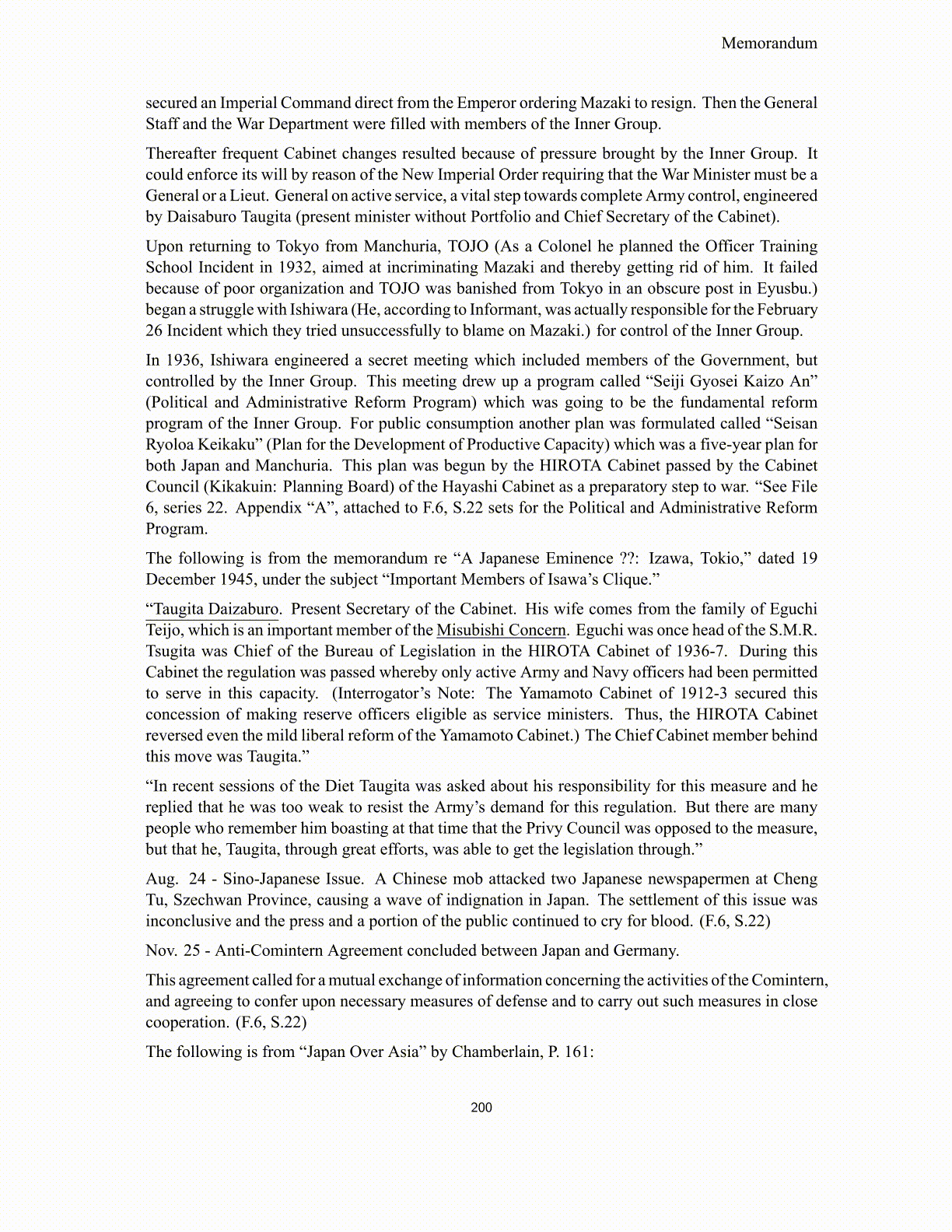
Memorandum secured an Imperial Command direct from the Emperor ordering Mazaki to resign. Then the General Staff and the War Department were filled with members of the Inner Group. Thereafter frequent Cabinet changes resulted because of pressure brought by the Inner Group. It could enforce its will by reason of the New Imperial Order requiring that the War Minister must be a General or a Lieut. General on active service, a vital step towards complete Army control, engineered by Daisaburo Taugita (present minister without Portfolio and Chief Secretary of the Cabinet). Upon returning to Tokyo from Manchuria, TOJO (As a Colonel he planned the Officer Training School Incident in 1932, aimed at incriminating Mazaki and thereby getting rid of him. It failed because of poor organization and TOJO was banished from Tokyo in an obscure post in Eyusbu.) began a struggle with Ishiwara (He, according to Informant, was actually responsible for the February 26 Incident which they tried unsuccessfully to blame on Mazaki.) for control of the Inner Group. In 1936, Ishiwara engineered a secret meeting which included members of the Government, but controlled by the Inner Group. This meeting drew up a program called “Seiji Gyosei Kaizo An” (Political and Administrative Reform Program) which was going to be the fundamental reform program of the Inner Group. For public consumption another plan was formulated called “Seisan Ryoloa Keikaku” (Plan for the Development of Productive Capacity) which was a five-year plan for both Japan and Manchuria. This plan was begun by the HIROTA Cabinet passed by the Cabinet Council (Kikakuin: Planning Board) of the Hayashi Cabinet as a preparatory step to war. “See File 6, series 22. Appendix “A”, attached to F.6, S.22 sets for the Political and Administrative Reform Program. The following is from the memorandum re “A Japanese Eminence ??: Izawa, Tokio,” dated 19 December 1945, under the subject “Important Members of Isawa’s Clique.” “Taugita Daizaburo . Present Secretary of the Cabinet. His wife comes from the family of Eguchi Teijo, which is an important member of the Misubishi Concern . Eguchi was once head of the S.M.R. Tsugita was Chief of the Bureau of Legislation in the HIROTA Cabinet of 1936-7. During this Cabinet the regulation was passed whereby only active Army and Navy officers had been permitted to serve in this capacity. (Interrogator’s Note: The Yamamoto Cabinet of 1912-3 secured this concession of making reserve officers eligible as service ministers. Thus, the HIROTA Cabinet reversed even the mild liberal reform of the Yamamoto Cabinet.) The Chief Cabinet member behind this move was Taugita.” “In recent sessions of the Diet Taugita was asked about his responsibility for this measure and he replied that he was too weak to resist the Army’s demand for this regulation. But there are many people who remember him boasting at that time that the Privy Council was opposed to the measure, but that he, Taugita, through great efforts, was able to get the legislation through.” Aug. 24 - Sino-Japanese Issue. A Chinese mob attacked two Japanese newspapermen at Cheng Tu, Szechwan Province, causing a wave of indignation in Japan. The settlement of this issue was inconclusive and the press and a portion of the public continued to cry for blood. (F.6, S.22) Nov. 25 - Anti-Comintern Agreement concluded between Japan and Germany. This agreement called for a mutual exchange of information concerning the activities of the Comintern, and agreeing to confer upon necessary measures of defense and to carry out such measures in close cooperation. (F.6, S.22) The following is from “Japan Over Asia” by Chamberlain, P. 161: 200